Former River Roads Mall Site Vacant, the Few New Buildings Aren’t Pedestrian Friendly
 River Roads Mall was located in the north St. Louis County municipality of Jennings, MO:
River Roads Mall was located in the north St. Louis County municipality of Jennings, MO:
Opened in 1962, the mall originally featured St. Louis-based Stix, Baer & Fuller as its main anchor store, as well as a Kroger supermarket and a Woolworth dime store. Walgreens operated a store in the mall as well. A 1970s expansion brought JCPenney as a second anchor store. Dillard’s bought the Stix, Baer & Fuller chain in 1984, converting all Stix, Baer & Fuller stores to the Dillard’s name. However, the River Roads Mall store was closed not long afterward in 1986 at the end of the lease. JCPenney converted its store to a JCPenney outlet in 1984. Woolworth closed the River Roads location (along with locations at West County Mall and in South St. Louis City) in early 1991 during one of the chain’s earliest rounds of store closures. By the early 1990s, the mall was briefly renamed St. Louis Consumer Center. (Wikipedia)
Two decades after opening it was already in decline. The surrounding residential neighborhoods remain a decent place to grow up.
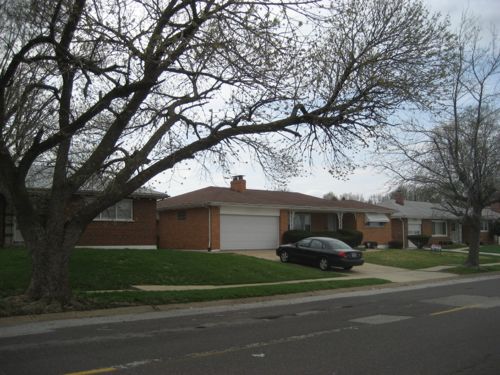
I love that sidewalks were provided, those didn’t exist in the 1960s subdivision where I grew up, but they’re meaningless because the sidewalks didn’t lead anyone to nearby retail. You see in the 1960s America thought driving everywhere was the future. Cart the kids around until they get a license then they can drive themselves.

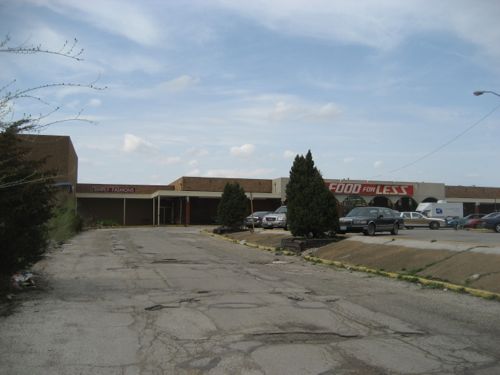


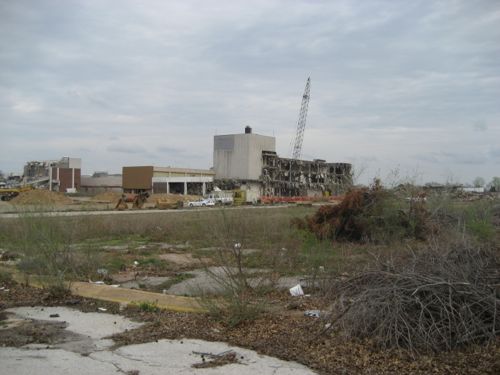
But we know better now, right? We need to design places to accommodate multiple modes of mobility: car, bike and foot. So you’d think the few new buildings that have been constructed in the last 5-6 years on the edge of the site have improved things for area residents. Well, you may not think so but I expected to see an improvement.
Boy was I disappointed on my first visit in 6+ years.

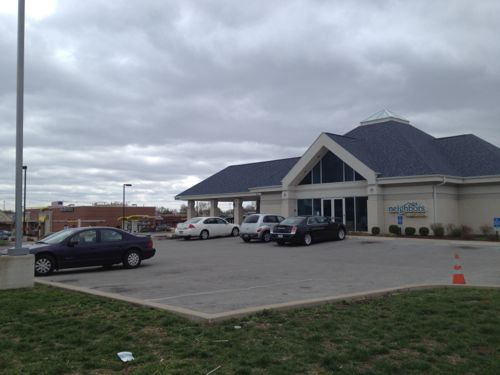
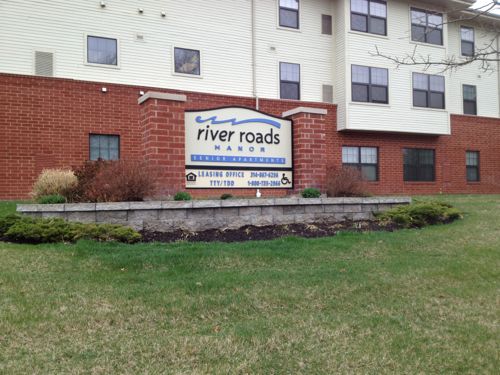
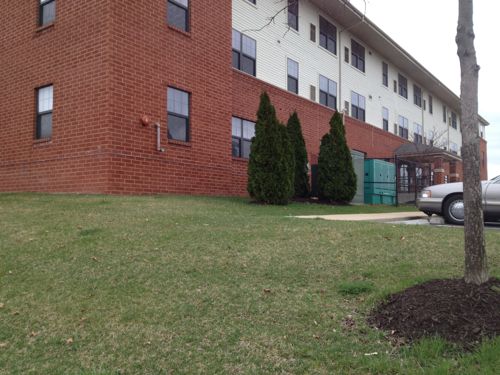
River Roads Manor was a Pyramid Properties project, completed prior to the collapse of the company on April 18, 2008 (see Five Years Since Pyramid Properties Ceased Operations). The McDonald’s & Neighbors Credit Union were started. So John Steffen’s Pyramid Properties is to blame for not raising the bar in this area.
I just hope Stacy Hastie of Environmental Operations, the entity that now owns the mall site, will take pedestrian access into consideration in the future. I also hope Jennings will realize their residents do walk places and that new construction should include provisions for them as well as for motorists.
Some of you will say nobody walks, everyone drives. Why then is the area serviced by MetroBus is everyone drives? All we have to do is take a look at Google Street View to spot pedestrians.
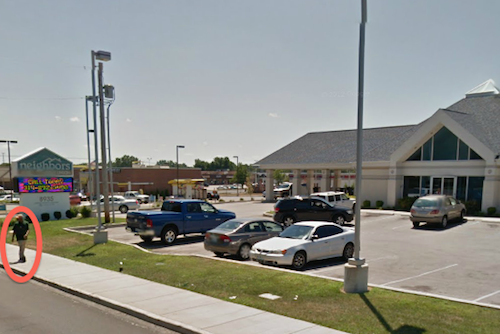


Massive efforts go into accommodating motorists, from municipal codes to vast amounts of paving and land. I just want a pedestrian connection to adjacent streets, I think that’s fair.
— Steve Patterson
First, I agree that better pedestrian connections would be a good thing. But, “I want” is not a very good reason, especially if you won’t be patronizing any of these establishments more than once, if at all. Life is not “fair”. You, I, and everyone else can go around finding problems that we “know”, intellectually, are “wrong” / “could be better”, yet don’t directly affect us. Did you ask any of the “many pedestrians waiting to catch the #16 MetroBus” what they thought? Did you ask any of the residents or employees of River Roads Manor what they thought?
We can all punish bad behavior by not patronizing these “bad” establishments, just like we can reward good behavior by patronizing “good” establishments (like the recently rebuilt Taco Bell on S. Kingshighway), but telling people what they should do (by bullying them?) to “accommodate” you and your unique needs and desires, then not returning seems to border on being immature and petty. A while back, you encouraged (forced?) the Schlafly Bottleworks in Maplewood to add a simple pedestrian connection (I know, I was there yesterday – didn’t use the new connection, but saw it) – when was the last time you were there? A while back, you encouraged (forced?) the St. Louis Bread Company in St. Louis Hills to add a more complex pedestrian connection (I know, I was there a week ago – didn’t use the new connection, but saw it) – when was the last time you were there?
My personal opinion is that we get the infrastructure in our communities that most of us want and use. If enough residents want good pedestrian connections, we get good pedestrian connections. If enough residents want 4-way stops, we get 4-way stops, on pretty much every corner. If enough residents want smoking banned, smoking gets banned. If enough customers want drive-thru’s, we get drive-thru’s. Government represents the will of the majority, but government can’t make everyone happy nor can government solve everyone’s real or perceived problems. Yes, every business “should” reach out to every potential customer, but if you want to see real consistency and real progress, good/better design needs to become ingrained at the local government level. Waging a one-man war to educate individual property owners, on a case-by-case basis, (and especially) after construction is completed, will just frustrate you and will do little, if anything, to fill in the missing links that fall in the public realm or on stable, declining or undeveloped private property.
Do you have anything better to do than to comment on every one of Steve’s posts and tell him he’s a naive busy-body? The blog is called “Urban Review STL” and Steve reviews the built and proposed urban environment of St. Louis and comments on the quality of the urban design. If you don’t like that then stop reading the blog.
I’ve lived in two cities (Denver and Louisville) that have done a much better job of providing walkable infrastructure for their citizens. I don’t disagree with Steve’s goals, I’m just pointing out the futility of his methods. Good design comes from strong, committed leadership in the public sector – government needs to consistently require compliance with ADA regulations as a part of their approval processes. ALL of the projects Steve uses as the poster children for poor urban design have been “approved” by some local government before they started construction. YES, these individual property owners AND their consultants SHOULD be doing a better job of complying, but the reality is that many commercial owners are unwilling to spend money to comply with anything beyond what the local jurisdiction requires. Instead of focusing his efforts on random completed projects, his efforts would be much more productive, in the long run, by focusing on the inadequacies in our current review processes AND working to tighten up current regulations. It’s simply a whole lot easier to make changes when they’re still on paper than when construction is completed.
And as for commenting, that’s what’s makes for interesting conversation. While some people are satisfied with “holding hands and singing Kumbaya”, I’ve found that spirited discussion usually results in better solutions or end products. Yes, this is Steve’s blog, and yes, he has every right to say whatever he wants. But to assume that Steve, or anyone else, including me, is always “right” is so far off base to be laughable. Sitting behind a computer and throwing bombs is easy, going to work in the public sector and (trying to) make a real difference is a lot harder.
I agree that influencing government policy before things happen is more effective than criticizing after the fact. I recently moved to Madison, WI and no longer live in STL. I see the night-and-day difference in the quality of the planning & urban design here vs. STL. Case-in-point: a new McDonalds (the older one was displaced by a new bridge for the commuter bike trail) and a bank were built on E. Washington Ave near to me. Both were built up to the curb, connected directly to the sidewalk, with bike parking (on a street with a striped bike lane), and within walking distance of transit. That’s because Madison has good leadership on these issues. People get involved much more here.
You say Steve should be involved and I’m sure he is. However, in STL, with it’s 100+ municipalities it’s impossible to be everywhere at once. Was Steve supposed to be sitting in on the Jennings city council meetings years ago pushing for a new urbanist mixed-use development for River Roads Mall? Because he didn’t does he now have no right to point out the bad development? That’s ridiculous. There’s still a lot of land left to develop on this site (as the photos show). This isn’t over with yet. Perhaps by drawing attention to the lack of oversight and good design so far, the rest of the development will be improved.
While setting policy is important, it’s also important to point out when governments or businesses aren’t acting in the public interest. Would you fault Upton Sinclair for pointing out the horrors of the Chicago meatpacking plants? Maybe he should have gotten involved in political oversight boards beforehand instead of complaining after the fact? He should have just become a vegetarian! He should have stopped bullying the poor industrialists! The people want cheap sausages and the businesses were only responding to the market! That mean old socialist…
I don’t advocate pedestrian access to satisfy my personal needs, I do it for the benefit of the entire community.
We don’t get what we want, we get what shortsighted people foist upon us. I’m sick of the crap we’ve been given. My voice is going to get louder and louder and hopefully more and more people will join me in speaking up for better design throughout our region.
We “may get the infrastructure we want” but I’d venture to say that the average person doesn’t realize there are other (better) options.
Thanks for pointing this out Steve. I appreciate all the hard work you do to try to make places–if not walkable–at least safely accessible by foot/bike/wheelchair. The suburban cheaply-built-one-use-building-surrounded-by-a-parking-lot is the default mode of construction in suburbia. This is not actually what people “want” anymore, this is just inertia. People are so used to it that the thought that something better could be built doesn’t even occur to them. Given the choice most folks want a mixed-use walkable environment. The first step to encouraging good development is to point out bad development, call a spade a spade and, if possible, publicly shame the people who perpetuate it. This is what you’re doing and it’s a good thing. Don’t listen to cynical naysayers and keep following your passion.
IF “this is not actually what people ‘want’ anymore,” why do we see it being repeated, not just in suburban areas, but in many parts of the city, as well, and in spite of our existing walkable infrastructure?! I agree, “The first step to encouraging good development is to point out bad development, call a spade a spade and, if possible, publicly shame the people who perpetuate it.” In my mind, that would be our elected officials, our “representatives”, the ones we elected to represent our views and to push our agendas. McDonald’s is fully capable of designing an appropriate solution for a walkable neighborhood. The problem, here and elsewhere, is that more of their customers CHOOSE to use the drive thru than to walk in, order at the counter, and, maybe, eat their food in the dining room. And until we change the behavior of the typical vehicle-driving consumer, businesses will continue to try and satisfy that (perceived? clueless? inertia?) demand – it doesn’t matter if it’s a bank, a pharmacy, a supermarket or a fast food place, we get what we get not because it’s “the default mode of construction in suburbia”, we get what we get because empirical data (actual sales) tell retailers what “crap” works best to sell what they’re selling!
So you think we need everyone to drive less and walk more before we should build an environment designed for walking as much as driving? Sorry, human nature doesn’t work that way. Some of us will get out front and walk/bike even though the environment is hostile. For others they need a more inviting space before they’ll give it a try. The last group will finally start once a majority are doing it.
No, I think that we can (and should) accommodate BOTH drivers and non-drivers. The problem is that, in most locations, drivers far outnumber non-drivers, so most retailers focus (exclusively?) on serving the needs and wants of drivers. If a minority’s interests (and that’s what non-drivers are, in most locations) are to be addressed, the government needs to force retailers to do so, and that’s best accomplished at the local level, where building permits are issued, where tap fees are collected and where curb cuts are approved. It’s called leverage. If you want to get your permits, you (and everyone else) must comply with whatever regulations are in place. It’s not that difficult to come up with the language requiring both usable public sidewalks and connections between the sidewalk and the front door (or landscaping or limits on signs or architectural design review). What’s apparently very difficult, at least around here, is finding politicians willing to “inconvenience” applicants by imposing any sort of “additional” requirements. It seems like our local politicians are so afraid of losing even a dollar in potential sales tax revenues (to say nothing of property taxes), that they roll (bend?) over every time any retailer complains about “all these unnecessary government regulations” . . . .
Agreed, both drivers and pedestrians should be considered. I’ve never advocated drivers not be, zoning & building codes have page after page on parking lot requirements. Reduce those while adding some for pedestrian.
But the time to bring it up is not at permit application. At that point the drawings are done and it’s a hassle to revise them.
When I see access done right it is because the developer/contractor/owner/architect/engineer voluntarily decided to accommodate pedestrians. I want to educate them so it happens more often while also pushing local/county/state governments to require it.
Unfortunately, that’s not reality. Architects and engineers research what the city is going to require before they start their plans, since most owners won’t (want to) pay for revised plans if they get rejected when they’re submitted for permits, while most owners don’t want to spend / “waste” money doing much extra to accommodate pedestrians or cyclists.
Thankfully many architects & engineers see their role as more than designing to the bare minimum, educating & showing their clients how they can create something superior than the lowest common denominator.
Yes, most designers will always suggest / push / insist on more than the bare minimum. Unfortunately, the golden rule (as in he who has the gold makes the rules) often kicks in, especially when it comes to retail, and even more frequently when the client is a chain or a developer. I don’t know how many commercial clients you’ve had over the course of your professional careers, but my perspective comes from doing commercial architecture for 35 years and dealing with multiple clients who have had little or no interest in doing much more than the bare minimum. It’s always all about the bottom line / making the numbers work, and only rarely about making the world a better place (except for their bottom lines).
See I don’t buy into your golden rule. I’ve spent my life changing rules.
Am I to assume that by “changing rules” you mean that you have had no commercial clients? Or that every client you’ve had has embraced your beliefs that every project requires new rules? I’d love it if I were treated as and respected as an all-knowing expert, able to dictate every design choice to my clients, but I have yet to experience that luxury, that level of freedom or that level of respect . . . .